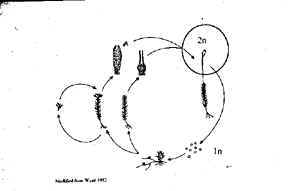General Information on Polytrichum
"The Hair Cap Mosses, called Bird Wheat
or Pigeon Wheat in many localities, are the largest and in some respects most highly
developed of all our mosses, and by reason of their size and common occurrence are
familiar object to nearly everyone. Many an old field and meadow is carpeted with
the dark rich green of the common Hair Cap. The farmer, however, votes it a pest, as
it often entirely supplants the grass over large areas of meadow. The hairy cap that
gives this genus of mosses its name is composed of long hairs growing from a little
scale-like body, the calyptra proper, at the top of the capsule. The Hair Caps, in
common with most other mosses, are subject to great extremes of moisture and dryness, and
their appearance when dry is very different firm what it is when moist, as the leaves of
the rosette are numerous antheridia. The male plants of many other dioicous
mosses end in a similar rosette. The leaves are large, not bordered, with a
sheathing membranous base and very numerous lamellae occupying the greater part of the
width of the leaf above the base, making the central portion of the leaf very dark and
dense" (Grout, 41).

Photograph courtesy of Dr. Robert Wyatt
Some uses of Polytrichum:
"When dry, even though
wholly alive, they burn like tinder. These mosses are used in European countries for
small brooms and for filling beds. It is said that the great Linnaeus often slept on
such beds" (Grout, 41). "Polytrichum
is almost always an indicator of acidic conditions"
(Crum, 355). Polytrichum commune can be used in some areas to
indicate high mercury (Hg) levels. To find out more information about this, click HERE!
Interesting Web Sites:
* Click HERE for a great site
containing general information on mosses, their life cycle, economic
importance, etc.
* Click HERE for more
general information on mosses using this botany web site
* Click HERE for a
glossary featuring helpful botany terms

